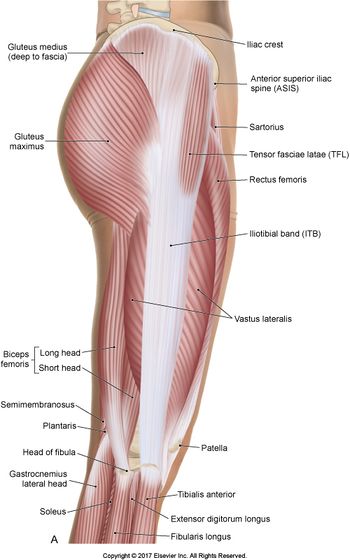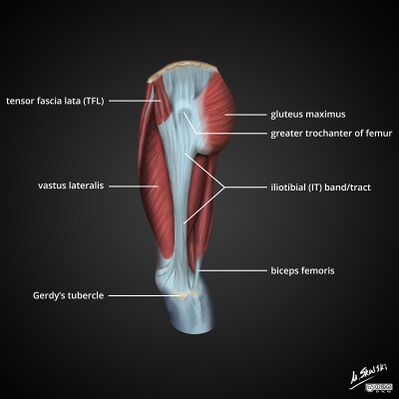Iliotibial Tract
Top Contributors - Eman Ammar and Lucinda hampton
Description[edit | edit source]
The iliotibial band (ITB) is a thick band of fascia formed proximally at the hip by the fascia of the gluteus maximus, gluteus medius and tensor fasciae latae muscles[1].
- The ITB runs along the lateral thigh and serves as an important structure involved in lower extremity motion.
- There are multiple clinical conditions that can present secondary to a spectrum of ITB dysfunction eg external snapping hip syndrome, ITB syndrome[2].
Image 1: The iliotibial band (ITB) is a thick band of fascia formed proximally at the hip by the fascia of the gluteus maximus, gluteus medius and tensor fasciae latae muscles.
Anatomy[edit | edit source]
The iliotibial band (ITB) is a thick band of fascia formed proximally at the hip by the fascia of the gluteus maximus, gluteus medius and tensor fasciae latae muscles.
The band consists of deep and superficial layers:
- The superficial layer is the main tendinous component and inserts onto Gerdy's tubercle on the anterior lateral tibia
- The deep layer inserts on the intermuscular septum of the distal femur
A small recess exists between the lateral femoral epicondyle and the ITB, which contains a synovial extension of the knee joint capsule (lateral synovial recess)[1]
The ITB shares the innervation of the TFL and gluteus maximus via the superior gluteal nerve and inferior gluteal nerve
Function.[edit | edit source]
Proximal ITB function includes:
- Hip extension
- Hip abduction
- Lateral hip rotation
Distally, ITB function depends on the position of the knee joint
- Full extension to 20 to 30 degrees of flexion: Active knee extensor, ITB lying anterior to the lateral femoral epicondyle
- 20 to 30 degrees of flexion to full flexion ROM: Active knee flexor, ITB lies posterior relative to the lateral femoral epicondyle[2]
Physiotherapy[edit | edit source]
The iliotibial band is one of the most common running injuries we see as physiotherapists. It is considered a non-traumatic overuse injury and is often concomitant with underlying weakness of hip abductor muscles. For more see Iliotibial Band Syndrome
External snapping hip syndrome is another ITB pathology you may encounter[3].
Clinical examination testing for ITB dysfunction is best elicited utilizing the Ober Test, see here
Treatment generally initiates with ITB stretching ,therapeutic exercises and physical therapy. NSAID use may be beneficial to reduce inflammation. Surgery is a last resort used for refractory cases.
Here is some corrective exercises:[edit | edit source]
1-Hip Bridge with Resistance Band[edit | edit source]
An effective yet simple exercise to begin with is the hip bridge utilizing a resistance band. Researchers Choi and colleagues found that gluteus maximus EMG activity was significantly greater while anterior pelvic tilt angle was significantly lower in the glute bridge with isometric hip abduction compared to the glute bridge without the band. Therefore, they concluded that performing glute bridges with isometric hip abduction against isometric elastic resistance can be used to increase gluteus maximus EMG activity and reduce anterior pelvic tilt during the exercise.
2-Side Lying Hip Abduction[edit | edit source]
The Side Lying Hip Abduction is a great way to isolate the glute medius. Distefano and colleagues looked at gluteal activation among common exercises and identified this as one of the top exercises.
3- Lateral Band Walk[edit | edit source]
Once you have isolated the gluteus medius you can now integrate a more functional exercise with the lateral band walk. Increased hip abduction strength has been shown to improve the ability of female athletes to control lower extremity alignment. (14) When performing this exercise, the stepping motion should be performed in a semi-squat position with the knees bent rather than an upright straight leg position in order to generate greater gluteus maximus and medius muscle activity[4].
4-Side Plank[edit | edit source]
start by performing 3-5 repetitions for 10 seconds each, gradually adding more repetitions.
Related articles[edit | edit source]
References[edit | edit source]
- ↑ 1.0 1.1 Radiopedia ITB Available: https://radiopaedia.org/articles/iliotibial-band?lang=gb (accessed 27.12.2021)
- ↑ 2.0 2.1 Hyland S, Graefe S, Varacallo M. Anatomy, bony pelvis and lower limb, iliotibial band (tract). StatPearls [Internet]. 2020 Aug 10.Available: https://www.ncbi.nlm.nih.gov/books/NBK537097/(accessed 27.12.2021)
- ↑ Winston P, Awan R, Cassidy JD, et al. Clinical examination and ultrasound of self-reported snapping hip syndrome in elite ballet dancers. Am J Sports Med. 2007 Jan;35(1):118–126. [PubMed]
- ↑ Berry et al. 2015. Resisted side-stepping: the effect of posture on hip abductor muscle activation. Journal of Orthopaedic & Sports Physical Therapy" />








